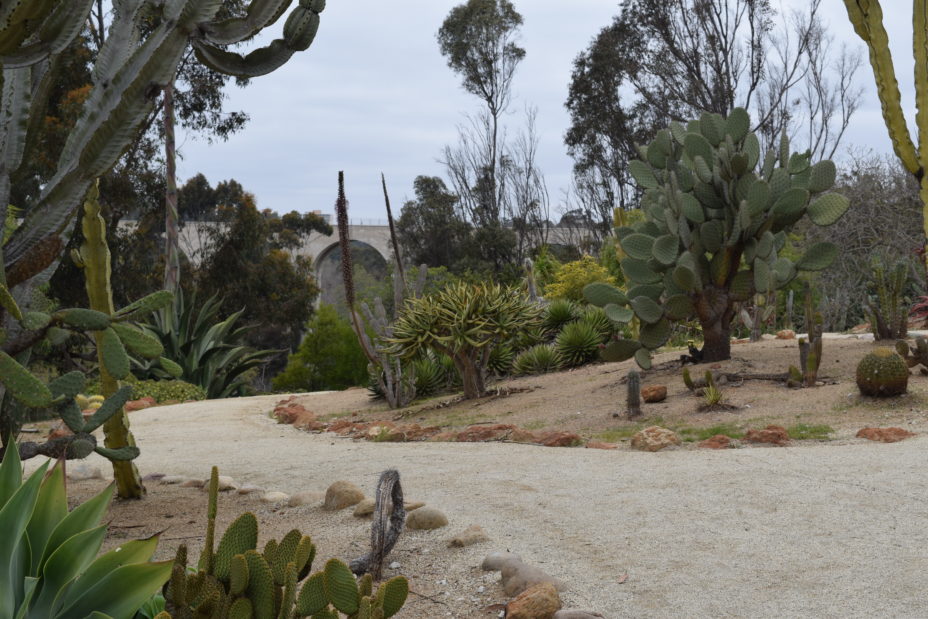Horticultural History: Kate Sessions’ Lost and Found Gardens of Balboa Park
This winter Nancy Carol Carter, club historian, spoke about three of Kate Sessions’ Gardens while giving us a healthy dose of Balboa Park’s history. The three gardens Kate authored for the Park are the Aloe and Agave Garden, the Cactus Garden and the San Jose Hester Palm Garden (or “grove,” Nancy says, “is more accurate.”)
Carter explained that there is much misinformation about Balboa Park and Kate Sessions. In 1892 Kate leased 32 acres of city parkland on which she re-located her nursery business. In lieu of rent, she agreed to plant 100 trees per year. In addition, she provided the city with 300 other trees for planting in other areas. During ten years in Balboa Park, she contributed over 1000 trees. The park was not landscaped, and in 1902 Kate moved her nursery to Lewis and Stephens Street in Mission Hills. Once in Mission Hills, Kate Sessions had no control over the park although her opinions and advice were sought and respected. The three gardens, which bear her name have, according to Nancy, her “green fingerprints all over them.”
Kate Sessions was well respected by people of influence in San Diego. When she became ill, in 1931 at the age of 74, San Diego citizens realized they might lose a major influence of beauty in San Diego. San Diego Floral Association wanted to reward her contributions with a dinner, but instead, Kate suggested creating a garden to attract visitors to Balboa Park. In 1932 the San Diego Floral Association established an Aloe and Agave Garden, which was presented to the City of San Diego and dedicated in honor of Kate Sessions. This garden has been lost, paved in 1971 to create a parking lot for the Spanish Village. However, before its demise, it was planted with a heavily researched collection of both aloe and agave.
Since Kate was friends with the Superintendent of Parks, John Morley, and with Chauncy Jerabek, a Balboa Park horticulturalist and member of San Diego Floral, she was able to enlist their help. Jerabek led the work on the garden. He kept meticulous records and researched the plants. Kate gave her entire collection to the garden, and people from San Diego and other areas donated unusual and special plants to the garden.
Another of Kate’s friends, William Hertrich of the Huntington Botanical Gardens shared his expertise as well. In 1935 San Diego Floral dedicated it, naming it the Kate O Sessions Aloe and Agave Garden. While it was an attraction in the 1935 Exposition, sadly the garden was not maintained. Many of the plants survived despite neglect and the survivors may have gone to the Cactus Garden or were bulldozed and paved over. The automobile won over the garden, and in 1971 it became the Spanish Village Parking Lot. One of ‘the best documented plant collections established in Balboa Park was neglected to death,” says Nancy.
The Cactus Garden was the result of Kate Session’s pressure. From 1899 until 1934 she published articles and made suggestions saying that San Diego had the ideal climate for the best cactus garden in the world. She felt it would be a unique feature of the park and finally got her way by suggesting it would be a great addition for the California Pacific International Exhibition in 1935.
She worked with Morley and Jerabek plus Richard Requa. Kate’s reputation meant that well-documented specimens came from all sources including Kate’s own collection. Arizona Federated Garden Clubs sent 15 tons of cactus plus a University employee to oversee and assist in planting.
Twenty giant seguerros arrived including one 12-feet tall. In 1936, the new Cactus Garden was recognized as one of the top three permanent landscape installations in Balboa Park. However, the Cactus Garden was almost another lost garden. From 1960 on, there were suggestions for making it more attractive, including a picnic area in lieu of the Balboa Club, which still remains. From 1940 until 2019 it was vandalized and neglected, but in 2019 money was donated to renovate it. Not surprising, some of the neglected plants flourished despite cruel treatment and neglect. This year it will be marked with new signage, which will carry its recently bestowed new name: the Kate O. Sessions Cactus Garden. It is more popular now as a site for special photographs.
Kate’s third garden is actually thriving. T.S. and Dr. Katharine Brandegee, a famous botanical couple who traveled extensively in search of unusual plant specimens, moved to San Diego in 1894. Naturally, they became friends with Kate Sessions. In 1902 they took Kate with them on an expedition to find an unknown palm in Baja California. After a four-day cruise from Ensenada to San Jose del Cabo, they mounted mules for a three-day trek to find the palms. This species had been neither classified nor imported to the United States.
Another botanist, Carl Albert Purpus, known for bringing tons of succulents and other “exotic” plants to Europe, claimed this was a new species and named it the San Jose Hesper Palm. Kate brought five palms and many bags of palm seeds, which she propagated on her Mission Hills land. She eventually sold 175 palms to Balboa Park and donated 150 of her own. They can still be seen skirting the Bowling Green and flowing down into Cabrillo Canyon.
It is easy to see why Kate Sessions is still revered in San Diego. She made many great contributions to its beauty.
The next meeting of the Mission Hills Garden Club will be from 6:30 p.m. to 8 p.m., Thursday, April 22 featuring Eric Olsen on Organic, Environmentally Conscious Container Gardening. To attend, go to www.MissionHillsGardenClub.org and RSVP to receive the Zoom coordinates.

Category: Architecture, Education, Local News, Nonprofit







